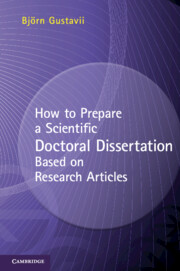Book contents
- Frontmatter
- Contents
- Preface
- Acknowledgments
- 1 Introduction
- 2 Compilation – the article-based thesis
- 3 Front cover illustration
- 4 Title
- 5 Abstract
- 6 Quotations
- 7 Thesis at a glance
- 8 Abbreviations
- 9 List of publications
- 10 Contributors
- 11 Popularized summary
- 12 Acknowledgments
- 13 General introduction
- 14 Aims
- 15 Methods
- 16 Results
- 17 General discussion
- 18 Copyright
- 19 A dissertation worth considering
- Appendix A To the authorities at the graduate division
- Literature cited
- Index
14 - Aims
Published online by Cambridge University Press: 05 November 2012
- Frontmatter
- Contents
- Preface
- Acknowledgments
- 1 Introduction
- 2 Compilation – the article-based thesis
- 3 Front cover illustration
- 4 Title
- 5 Abstract
- 6 Quotations
- 7 Thesis at a glance
- 8 Abbreviations
- 9 List of publications
- 10 Contributors
- 11 Popularized summary
- 12 Acknowledgments
- 13 General introduction
- 14 Aims
- 15 Methods
- 16 Results
- 17 General discussion
- 18 Copyright
- 19 A dissertation worth considering
- Appendix A To the authorities at the graduate division
- Literature cited
- Index
Summary
Also called Research questions, Objectives, Purpose or Scope of the thesis.
Do not use abbreviations here; but if you do, explain them (see Chapter 8, “Abbreviations”).
One concise sentence for each aim is often sufficient. You may present them as bullet points (as here) or in a paragraph of text. Instead of beginning these sentences with synonyms:
The aims were:
to study …
to investigate …
to determine …
to examine …
to document …
… try, as an umbrella, one of them, and avoid introducing synonyms (Alexey Schramko 2010):
The goals were to determine
the effects of a single dose …
the mechanisms of …
the hemodynamic profile …
Information
- Type
- Chapter
- Information
- Publisher: Cambridge University PressPrint publication year: 2012
